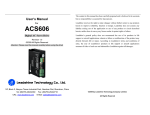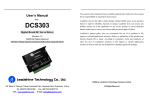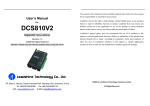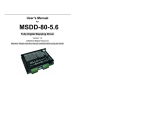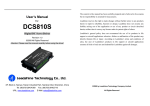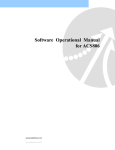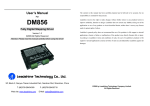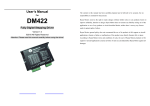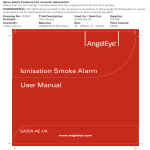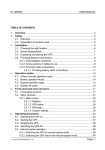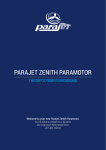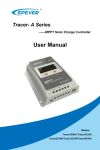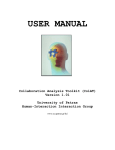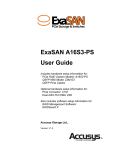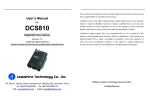Download ACS806 - Leadshine
Transcript
User’s Manual For ACS806 Digital AC Servo Drive Revision 1.0 ©2009 All Rights Reserved Attention: Please read this manual carefully before using the drive! 3/F, Block 2, Nanyou Tianan Industrial Park, Nanshan Dist, Shenzhen, China Tel: (86)755-26434369 Fax: (86)755-26402718 URL: www.leadshine.com E-Mail: [email protected] The content in this manual has been carefully prepared and is believed to be accurate, but no responsibility is assumed for inaccuracies. Leadshine reserves the right to make changes without further notice to any products herein to improve reliability, function or design. Leadshine does not assume any liability arising out of the application or use of any product or circuit described herein; neither does it convey any license under its patent rights of others. Leadshine’s general policy does not recommend the use of its products in life support or aircraft applications wherein a failure or malfunction of the product may directly threaten life or injury. According to Leadshine’s terms and conditions of sales, the user of Leadshine’s products in life support or aircraft applications assumes all risks of such use and indemnifies Leadshine against all damages. ©2009 by Leadshine Technology Company Limited. All Rights Reserved Contents Contents Table of Contents 1. Introduction, Features and Applications...................................................................1 Introduction ...........................................................................................................1 Features .................................................................................................................1 Applications ..........................................................................................................2 2. Specifications and Operating Environment..............................................................2 Electrical Specifications ........................................................................................2 Performance Specifications ...................................................................................2 Mechanical Specifications.....................................................................................3 Elimination of Heat ...............................................................................................3 Operating Environment and Parameters................................................................3 3. Connections..............................................................................................................4 Connector Configuration.......................................................................................4 General Information .....................................................................................4 More about I/O Signals ................................................................................6 ENA, PUL, DIR Input Circuits and Connections..................................................7 RL, FL Input Circuits and Connections.................................................................8 Pend, ALM Output Circuits and Connections .......................................................9 A+, A-, B+, B-, Z+, Z- Output Circuit ..................................................................9 Encoder and Hall Sensor Connections ................................................................10 RS232 Interface Connection................................................................................ 11 Typical Connections ............................................................................................ 11 4. Servo Setup ............................................................................................................13 Install Encoder and Hall sensor ...........................................................................13 Prepare Power Supply .........................................................................................13 Regulated or Unregulated Power Supply ...................................................13 Selecting Supply Voltage............................................................................14 Prepare Controller ...............................................................................................14 Tel: (86)755-26434369 I Web site: www.leadshine.com System Connections and Noise Prevention .........................................................14 Wire Gauge.................................................................................................14 Cable Routing.............................................................................................15 Twisted Wires .............................................................................................15 Cable Shielding ..........................................................................................15 System Grounding......................................................................................16 Power Supply Connection ..........................................................................16 5. Tuning the Servo ....................................................................................................17 Testing the Servo .................................................................................................17 Tuning the Servo .................................................................................................17 6. PC window based Tuning Using ProTuner ............................................................19 Introduction to ProTuner .....................................................................................19 Before Tuning......................................................................................................19 ProTuner Installation ..................................................................................19 Hardware Configurations before Tuning....................................................23 ProTuner for the ACS806 at Startup Window ............................................24 Introduction to ProTuner for the ACS806 ..................................................25 Communication Setup ................................................................................26 Software Configuration before Tuning.......................................................27 Current Loop Tuning ...........................................................................................27 Position Loop Tuning ..........................................................................................31 Position Loop Introduction.........................................................................31 Position around Velocity ............................................................................31 Position around Torque...............................................................................31 Start to Tune ...............................................................................................32 Upload and Download Data ................................................................................42 Download Data to EEPROM .....................................................................42 Upload the Data from EEPROM................................................................42 Save Data on Harddisk...............................................................................43 Download Data to Device ..........................................................................43 Tel: (86)755-26434369 II Website: www.leadshine.com ACS806 Digital AC Servo Drive Manua l Rev1.0 Contents Control Signal Input Mode..................................................................................45 More Informaiton about ProTuner.......................................................................45 T_Speed_Par tab ........................................................................................45 CurveSetting tab.........................................................................................46 Digital Scope Window................................................................................47 Error Check Window..................................................................................47 7.Using Tips ...............................................................................................................49 Change PPR by Electronic Gear..........................................................................49 Position following Error Limit ............................................................................50 Sequence Chart of Control Signals......................................................................50 Protection Functions............................................................................................51 Over-current Protection..............................................................................51 Over-voltage Protection .............................................................................51 Under-voltage Protection............................................................................51 Phase Error Protection................................................................................51 Encoder or Hall Error Protection................................................................51 Limit Error Protection ................................................................................52 Position Following Error Protection...........................................................52 Protection Indications.................................................................................52 Maximum Pulse Input Frequency .......................................................................52 8. Accessories .............................................................................................................53 ACS806 Accessories and Connections................................................................53 More Information about ACS806 Accessories ....................................................54 APPENDIX ................................................................................................................58 TWELVE MONTH LIMITED WARRANTY ....................................................58 EXCLUSIONS ....................................................................................................58 OBTAINING WARRANTY SERVICE ..............................................................58 WARRANTY LIMITATIONS.............................................................................58 SHIPPING FAILED PRODUCT.........................................................................59 Contact Us..................................................................................................................60 Tel: (86)755-26434369 III Website: www.leadshine.com 1. Introduction, Features and Applications Introduction Leadshine's fully digital AC servo drive ACS806 is developed with 32-bit DSP based on advanced control algorithm. Since its input commands are PUL/DIR signals, the users can upgrade stepping drives to the ACS806 without changing control systems. The ACS806 can offer high precision, high speed and high reliability performance, and widely used in inkjet printers, engraving machines, and etc. A built-in controller can be used for testing and tuning. PC based and handheld configuration & tuning tools can meet different tuning environments or requirements. Features l Input: 18 - 80VDC, l Peak Current: 18A , Continuous Current: 6 A (Max), 50 - 400 W l FOC-SVPWM technologies l PC based and handheld configuration tools l Electronic gear rate from 1/255 to 255 l Self-test function with trapezoidal velocity profile l Support PUL/DIR and CW/CCW control signals l Opto-isolated, support single-ended and differential inputs l Encoder output l Following error lock range adjustable l Over-voltage, over-current, encoder failure protections l 10 latest failures self-record function l Small size, surface-mount technology Tel: (86)755-26434369 1 Website: www.leadshine.com ACS806 Digital AC Servo drive Manual Rev1.0 Applications ACS806 Digital AC Servo drive Manual Rev1.0 Mechanical Specifications (unit: mm[inch]) 166[ 6.535] Suitable for large and medium automation machines and equipments, such as inkjet printers, engraving machines, electronics manufacturing equipments, special NC machines, pick and place devices, packing devices, and so on. Particularly adapt to the applications require high speed, high precision, and low motor noise. 3[ 0.118] 5[ 0.197] R1.5[ 0.059] 97[ 3.819] 50[ 1.969] 2. Specifications and Operating Environment 3[ 0.118] 22[ 0.866] Electrical Specifications (Tj = 25℃/77℉) ACS806 Parameters 150[5.906] Min. Typical Max. Unit Peak output current 0 - 18 A Continue output current 0 - 6 A +18 - +80 VDC Logic signal current 7 10 16 mA Pulse input frequency 0 - 600 kHz 32[ 1.260] 3[ 0.118] 15.5[ 0.610] Supply voltage Isolation resistance Current provided to encoder 500 - MΩ - 100 Figure 1: Mechanical specifications Elimination of Heat l mA l Drive’s reliable working temperature should be <70℃[158℉], and motor working temperature should be <80℃[176℉]. It is recommended to mount the drive vertically to maximize heat sink area. Performance Specifications (with ACM Series Servo Motors) l l l l l l l l Operating Environment and Parameters Position following error : +/-1 count Velocity accuracy: +/-2rpm Maximum acceleration speed (No Load) : 80 rpm/ms2 Input frequency up to 600 kHz Maximum speed : 4000 rpm Allowable low speed reaches1 rpm Positioning accuracy :+/-1 count Suitable for 18 - 80 VDC AC servo motors Tel: (86)755-26434369 2 Cooling Operating Environment Website: www.leadshine.com Natural cooling or Forced cooling Avoid dust, oil fog and corrosive gases Environment Ambient Temperature 0℃-50℃ (32℉-122℉) Humidity 40%RH-90%RH Vibration 5.9m/s2 Max Storage Temperature -20℃-65℃ (-4℉-149℉) Weight Approx. 450g (15.88oz) Tel: (86)755-26434369 3 Website: www.leadshine.com ACS806 Digital AC Servo drive Manual Rev1.0 3. Connections Connector Configuration General Information ACS806 Digital AC Servo drive Manual Rev1.0 22 B+ Encoder channel B+ output O 23 B- Encoder channel B- output O 24 Z+ Encoder channel Z+ output O 25 Z- Encoder channel Z- output O 26 SGND Halls & Encoder Connector Digital & Analog I/O Connector Pin Signal 1 ENA+ Description Enable signal input + I/O Pin Signal 1 EA+ Encoder channel A+ input I 2 3 4 EB+ EGND HallW+ Encoder channel B+ input Signal ground Hall sensor W+ input I GND I 5 6 HallU+ FG Hall sensor U+ input Ground terminal for shielded I GND 7 8 EZ+ EZ- 9 10 HallV+ HallV- 2 ENA- Enable signal input - I I 3 PUL+ Pulse signal input + I 4 PUL- Pulse signal input - I 5 DIR+ Direction signal input + I 6 DIR- Direction signal input - I 7 FL Positive limit signal input I 8 RL Negative limit signal input I 9 SGND Signal ground 10 Pend+ In position signal output+ GND O 11 Pend- In position signal output- O 12 ALM+ Alarm output signal+ O 13 ALM- Alarm output signal- O 14 NC Not connected - 15 NC Not connected - 16 NC Not connected 17 FG Ground terminal for shield GND 18 SGND Signal ground GND 19 +5V +5V@10mA power supply O 20 A+ Encoder channel A+ output O 21 A- Encoder channel A- output O Tel: (86)755-26434369 - 4 GND Signal ground Website: www.leadshine.com Description I/O Encoder channel Z+ input Encoder channel Z- input I I Hall sensor V+ input Hall sensor V- input I I 11 EA- Encoder channel A- input I 12 13 14 EBVCC HallW- Encoder channel B- input +5V @ 100 mA max. Hall sensor W- input I O I 15 HallU- Hall sensor U- input I High Voltage Connector Pin 1 2 Signal PE U Motor case ground Motor phase U 3 4 5 V W Rbrake Motor phase V Motor phase W Brake resistor connection (VDC-RBrake) 6 7 +Vdc GND Tel: (86)755-26434369 Description I/O GND O DC power Input (18-80VDC) Power Ground. 5 O O I I GND Website: www.leadshine.com ACS806 Digital AC Servo drive Manual Rev1.0 RS232 Communication Connector Pin 1 2 3 Signal NC +5V TxD Not connected +5V power only for STU. RS232 transmit. Description 4 GND Ground. 5 6 RxD NC RS232 receive. Not connected I/O O O GND ACS806 Digital AC Servo drive Manual Rev1.0 Pend+/Pend- In position signal output. OC output, high impedance when the position error is more than 2 pulses and low impedance when the position error is less than 2 pluses. ALM+/ALM- Alarm signal output. OC output, high impedance when the working status is normal and low impedance when over-voltage, over-current, phase error, encoder error, limit error, position following error happens. A+/A-/B+ /B-/Z+/Z- Encoder feedback signals output, usually offered to the controller for external velocity/position loop. I - More about I/O Signals ENA, PUL, DIR Input Circuits and Connections Signal Description ENA+/ENA- Enable input signal. This signal used for enabling/disabling the drive. High level for enabling the drive and low level for disabling the drive. Usually left UNCONNECTED (ENABLED). PUL+/PUL- Pulse input signal. In single pulse (pulse/direction) mode, this input represents pulse signal, each rising or falling edge active (software configurable); 4-5V when PUL-HIGH, 0-0.5V when PUL-LOW. In double pulse mode (pulse/pulse) , this input represents clockwise (CW) pulse,active at both high level and low level . For reliable response, pulse width should be longer than 0.85μs. Series connect resistors for current-limiting when +12V or +24V used. The same as DIR and ENA signals. DIR+/DIR- Directions input signal. In single-pulse mode, this signal has low/high voltage levels, representing two directions of motor rotation; in double-pulse mode (software configurable), this signal is counter-clock (CCW) pulse,active at both high level and low level. For reliable motion response, DIR signal should be ahead of PUL signal by 5μs at least. 4-5V when DIR-HIGH, 0-0.5V when DIR-LOW. FL/RL Positive or negative limit input signal. Use signal ground for reference. 0-0.5V is Low level input and 4-5V is High Level input. The active level can be set with configuration tools such as ProTuner, STU-ACS. If active at low level, FL/RL must be kept at high level for normal drive operation, and the drive will short-circuit the motor coils to stop the motor immediately when FL/RL turn to low level. If active at high level, FL/RL must be kept at low level for normal drive operation, and the drive will short-circuit the motor coils to stop the motor immediately when FL /RL turn to high level. Please select active at high level when RL/RL is not connected. The ACS806 has 3 differential logic inputs to accept Enable, Pulse and Direction control signals. These inputs are isolated to minimize or eliminate electrical noises coupled onto the control signals. Recommend use twisted wires and shielding cable for control signals to increase noise immunity in interference environments. Keep these wires far away from the power lines. In figure 2, input circuit for these control signals and connections to a typical motion controller is illustrated. Figure 3 illustrates connections to the controller with common-anode outputs. Figure 2: Connections to controller with differential outputs Tel: (86)755-26434369 6 Website: www.leadshine.com Tel: (86)755-26434369 7 Website: www.leadshine.com ACS806 Digital AC Servo drive Manual Rev1.0 ACS806 Digital AC Servo drive Manual Rev1.0 Pend, ALM Output Circuits and Connections Figure 5: Output circuit and connection for Pend and ALM Figure 3: connections to controller with Common-Anode outputs A+, A-, B+, B-, Z+, Z- Output Circuit RL, FL Input Circuits and Connections Recommend using the +5V supply output pin Digital & Analog I/O for FL/RL input. Figure 6: A+, A-, B+, B-, Z+, Z- output circuit Figure 4: Input circuit and connections for RL and FL Tel: (86)755-26434369 8 Website: www.leadshine.com Tel: (86)755-26434369 9 Website: www.leadshine.com ACS806 Digital AC Servo drive Manual Rev1.0 Encoder and Hall Sensor Connections ACS806 Digital AC Servo drive Manual Rev1.0 RS232 Interface Connection The ACS806 can accept both incremental encoder and Hall Effect sensor inputs for motor shaft position feedbacks. Note that twisted-pair shielded cabling provides the best immunity in electrically noisy environments. The ACS806 has the +5V power to supply the encoder & hall sensor. If the encoder and hall sensor drains less than 100mA, the ACS806 can supply them directly, and connect it as Figure 7. If the encoder drains more than 50mA, use an external DC supply and connect it as Figure 8. Figure 9: RS232 interface connection Typical Connections A typical connection of the ACS806 is shown as Figure 10. Please consult “Digital and Analog I/O” and “Encoder and hall sensor Connections” for more information about controller and encoder connections. Figure 7: The ACS806 supplies the encoder directly Figure 8: Using external DC power supply to supply the encoder Tel: (86)755-26434369 10 Website: www.leadshine.com Tel: (86)755-26434369 11 Website: www.leadshine.com ACS806 Digital AC Servo drive Manual Rev1.0 ACS806 Digital AC Servo drive Manual Rev1.0 4. Servo Setup Before you start the servo, you can follow the below steps. Install Encoder and Hall sensor Encoder and Hall sensor provide information of the motor shaft position and rotor magnetic field orientation. The output signals from the Hall sensor have absolute phase information which is used at motor startup. If your motor has no encoder and hall sensor, you must have an encoder (more than 200 lines) and hall sensor properly mounted on the motor before you start. There are some modules which can output signals both for encoder and hall sensor. Please assemble the selected module according to its factory manual. Leadshine also offer ACM series AC servo motors for matching the ACS806. Please use shielded cables and separate encoder signal cable from interference sources, such as motor wires and power wires at least 5 cm. Prepare Power Supply Regulated or Unregulated Power Supply Both regulated and unregulated power supplies can be used to supply the Drive. However, unregulated power supplies are preferred due to their ability to withstand current surge. If regulated power supplies (such as most switching supplies.) are indeed used, it is important to have large current output rating to avoid problems like current clamp, for example using 4A supply for 3A motor-drive operation. On the other hand, if unregulated supply is used, one may use a power supply of lower current rating than that of motor (typically 50%~70% of motor current). The reason is that the Drive draws current from the power supply capacitor of the unregulated supply only during the ON duration of the PWM cycle, but not during the OFF duration. Therefore, the average current withdrawn from power supply is Figure 10: Typical connection of the ACS806 Tel: (86)755-26434369 12 Website: www.leadshine.com Tel: (86)755-26434369 13 Website: www.leadshine.com ACS806 Digital AC Servo drive Manual Rev1.0 ACS806 Digital AC Servo drive Manual Rev1.0 considerably less than motor current. For example, two 3A motors can be well supplied by one power supply of 4A rating. Selecting Supply Voltage Current (A) Minimum wire size (AWG) 10 #20 15 #18 20 #16 The ACS806 can actually operate within +18 ~ +80VDC, including power input fluctuation and back EMF voltage generated by motor coils during motor shaft deceleration. The rated voltage of the motor is an important parameter when selecting supply voltage. Generally speaking, do not use a power supply voltage more than 5 volts of the rated voltage of the motor. Higher voltage may cause bigger motor vibration at lower speed, and it may also cause over-voltage protection or even drive damage. Cable Routing Prepare Controller Twisted wires effectively increasing noise immunity. The successive twists eliminate noise transients along the length of the cable. Both signal cables and power cables should be of the twisted and shielded type. Differential signal wires should be twisted as a pair. The combination of twisted pair wires and a differential signal significantly adds to noise immunity. Power wires should be twisted as a group along with the ground (or chassis) wire, if available. Prepare a controller with pulse and direction signals. However, the ACS806 has a built-in motion controller for self-test and Servo Tuning. The built-in motion controller can generate control signal with trapezoidal velocity profile. System Connections and Noise Prevention After finishing the above steps, you can connect your servo system. Before you start, make sure that the power is off. Connect your system according to previous connection diagrams, and pay attention to the following tips when wiring. Wire Gauge The smaller wire diameter (lower gauge), the higher impedance. Higher impedance wire will broadcast more noise than lower impedance wire. Therefore, when selecting the wire gauge, it is preferable to select lower gauge (i.e. larger diameter) wire. This recommendation becomes more critical as the cable length increases. Use the following table to select the appropriate wire size to use in your application. Tel: (86)755-26434369 14 Website: www.leadshine.com All content sensitive signal wires should be routed as far away from motor power wires and Drive power wires as possible. Motor power and Drive power wires are major sources of noise and can easily corrupt a nearby signal. This issue becomes increasingly important with longer motor power and Drive power wires lengths. Twisted Wires Cable Shielding All signal wires should be bundled and shielded separately from Drive power and motor power wires. Power wires should also be bundled and shielded. When grounding a shield, the rule-of-thumb is to do so at the ‘source’ of power while leaving the other shield end open. For example, in the case of motor power wires, this would be the drive side. Ideally, twisted pairs should be individually shielded and isolated from the outer shield, which encompasses all wires within the cable. However, since this type of stringent shielding practice is often not required, typical cables do not provide isolation between inner and outer shields. Tel: (86)755-26434369 15 Website: www.leadshine.com ACS806 Digital AC Servo drive Manual Rev1.0 System Grounding 5. Tuning the Servo Good grounding practices help reduce the majority of noise present in a system. All common grounds within an isolated system should be tied to PE (protective earth) through a ‘SINGLE’ low resistance point. Avoiding repetitive links to PE creating ground loops, which is a frequent source of noise. Central point grounding should also be applied to cable shielding; shields should be open on one end and grounded on the other. Close attention should also be given to chassis wires. For example, motors are typically supplied with a chassis wire. If this chassis wire is connected to PE, but the motor chassis itself is attached to the machine frame, which is also connected to PE, a ground loop will be created. Wires used for grounding should be of a heavy gauge and as short as possible. Unused wiring should also be grounded when safe to do so since wires left floating can act as large antennas, which contribute to EMI. Power Supply Connection NEVER connect power and ground in the wrong direction, because it will damage the ACS806 drive. The distance between the DC power supply of the drive and the drive itself should be as short as possible since the cable between the two is a source of noise. When the power supply lines are longer than 50 cm, a 1000µF/100V electrolytic capacitor should be connected between the terminal “GND” and the terminal “+VDC”. This capacitor stabilizes the voltage supplied to the drive as well as filters noise on the power supply line. Please note that the polarity can not be reversed. It is recommended to have multiple drives to share one power supply to reduce cost if the supply has enough capacity. To avoid cross interference, DO NOT daisy-chain the power supply input pins of the drives. Instead, please connect them to power supply separately. Tel: (86)755-26434369 ACS806 Digital AC Servo drive Manual Rev1.0 16 Website: www.leadshine.com Testing the Servo You may wish to secure the motor so it can’t jump off the bench. Turn on the power supply, the green (Power) LED will light. The ACS806 has default parameters stored in the drive. If the system has no hardware and wirings problem, the motor should be locked and the drive should be ready. If the motor jumps slightly and the red LED immediately turns on (flickers), then either the motor or the encoder is wired in reversal. Open the tuning software ProTuner and check drive status by clicking Err_check. If it’s Phase Error, then reversal motor wires or exchange encoder inputs and try again. If it’s Encoder Error, please check encoder and its wirings, and then try again. If it still doesn’t work after you followed all of the previous steps, please contact us at [email protected]. If the red LED is off and the motor is normal, then you can start to tune the servo with selected tool. PC based tuning software ProTuner and handheld small servo tuning unit STU are available for the ACS806. Tuning the Servo A servo system is error-driven. The “Gain” of the system determines how hard the servo tries to reduce the error. A high-gain system can produce large correcting torques when the error is very small. A high gain is required if the output is required to follow the input faithfully with minimal error. A servo motor and its load both have inertia, which the servo amplifier must accelerate and decelerate while attempting to follow a change at the input. The presence of the inertia will tend to result in over-correction, with the system oscillating beyond either side of its target. It’s called UNDER DAMPED status. See Figure 11. This oscillation must be damped, but too much damping will cause the Tel: (86)755-26434369 17 Website: www.leadshine.com ACS806 Digital AC Servo drive Manual Rev1.0 response to be sluggish, namely cause the system to get into an OVER DAMPED state. When we tune a servo, we are trying to achieve the fastest response with little or no overshoot, namely get a CRITICALLY DAMPED response. As mentioned in previous contents, the ACS806 is a digital servo drive and its input command is PUL/DIR signal. In other words, step response just exists in each step command signal. For each step command signal is a very small movement, so OVER SHOOT and SETTLING TIME between each step are very small, causing you hardly can see a step response such as Figure 11, even if the SET POINT is a very large quantity and the acceleration is very high. However, if you try to evaluate performances of the digital servo by investigating its position tracking-error or position following error, you may find it’s much easier than investigating its step response. The easiest way to get a tracking-error or position following error response is to induce an impulse load on the motor. See Figure 11 at “time 20”. Leadshine offers a Windows based setup software ProTuner to its customers for evaluating servo performances. Small servo tuning unit STU (optional) is available too, and it’s for field tuning without PC. 18 Tuning servo systems formed by the ACS806 can be summarized as the following rules: 1. If servo system is UNSTABLE, then the first thing of tuning is to stabilize the system. You can increase Derivative Gain of Position Loop (Kd) or decrease Proportional Gain of Position Loop (Kp) or Integral Gain of Position Loop (Ki). 2. If servo system is UNDER DAMPED, then increase Kd or decrease Kp or Ki. 3. If servo system is CRITICALLY DAMPED, then stop tuning and download the parameter settings to the Drive’s EEPROM. 4. If servo system is OVER DAMPED, then decrease Kd or increase Kp or Ki. 6. PC window based Tuning Using ProTuner Figure 11: Step and impulse responses Tel: (86)755-26434369 ACS806 Digital AC Servo drive Manual Rev1.0 Website: www.leadshine.com Introduction to ProTuner As a professional tuning tool, ProTuner has been developed specially for all Leadshine digital drives. It can be also used to configure the servo drive for many settings such as control signal modes, number of motor poles, position following error limit, default move direction, and etc. The most important feature is ProTuner offers the numeric method for tuning position-loop parameters (Kp, Kd, Ki) and give a visualization result synchronously for users to evaluate the performance of the system. Before Tuning ProTuner Installation The ProTuner is windows based setup software for tuning Leadshine’s digital drives. It can run in windows systems, including Win95/Win98/WindowsNT/Windows2000 Tel: (86)755-26434369 19 Website: www.leadshine.com ACS806 Digital AC Servo drive Manual Rev1.0 /Windows XP. And the selected PC should have 1 serial port at least for communicating with the drive. Double click “ProTuner_All_Setup_V1.0.exe” to begin installing the ProTuner. See Figure 12. Click Next to enter the “License Agreement” window. See Figure 13. ACS806 Digital AC Servo drive Manual Rev1.0 Choose “I agree to the terms of this license agreement” and click Next to continue installation. The user can enter user’s information in the following window. See Figure 14. After entering the user’s information, click Next to select installation folder, where you would like to install the ProTuner. See Figure 15. Note: ProTuner_All_Setup_V1.0.exe can be used for all Leadshine digital drives. User can get it from either Leadshine CD or website. Please get the latest version from http://www.leadshine.com. Figure 14: User’s information settings Figure 12: Begin to install the ProTuner Figure 15: Installation folder settings Figure 13: License agreement Tel: (86)755-26434369 20 Website: www.leadshine.com Tel: (86)755-26434369 21 Website: www.leadshine.com ACS806 Digital AC Servo drive Manual Rev1.0 ACS806 Digital AC Servo drive Manual Rev1.0 Figure 16: Shortcut folder setting Figure 18: Installing the ProTuner Set the “Shortcut Folder” in Figure 16 and continue to install the ProTuner by following Figure 17 and Figure 18. An Installation Successful window will appear if the ProTuner is installed successfully. See Figure 19. Figure 19: Finish installation Note: Leadshine also offers special version ProTuner which does not need installation. Please visit our website www.leadshine.com for latest ProTuner. Hardware Configurations before Tuning Figure 17: Installation information summarization ProTuner uses PC RS232 port to communicate with the ACS806. The ACS806 has a RJ-11 connector in which a special RS232 cable is connected to PC RS232 port. Before opening ProTuner to tune the ACS806, the following configuration must be Tel: (86)755-26434369 22 Website: www.leadshine.com Tel: (86)755-26434369 23 Website: www.leadshine.com ACS806 Digital AC Servo drive Manual Rev1.0 achieved as figure 20. 1. A power supply which has sufficient output current at related voltage; 2. AC servo or DC brushless servo motor (power range: 50 – 400W) with encoder and hall sensor feedback. 3. Table PC/Notebook with one RS232 communication port at least or a USB to RS232 adapter. Recommend using Table PC with RS232 port. 4. A special RS232 cable offered by Leadsine in which one end is a RJ-11 connector and the other end is a DB9 connector. ACS806 Digital AC Servo drive Manual Rev1.0 to clear the errors if red LED indicator flickers. Open ProTuner and the startup window appears as figure 21. For the ACS806, please select the ACS806 in AC Servo tab then click OK button. Drive Select Figure 21: Startup Window of ProTuner Introduction to ProTuner for the ACS806 Figure 20: Configuration and connections before Tuning 1. Main Window Many of the Leadshine products have similar user interfaces like figure 22. Note: 1. If it is the first installation, strongly recommended that tuning the ACS806 and AC servo motor without motor shaft coupling to any load. After basic values of the parameters are achieved, connect the motor to the load for further tuning. These basic parameters can also be used for other drives with the same servo motors. 2. Please double check the connections and make sure the motor would not jump off before powering on the drive if start at a high acceleration. 3. In order to setup communication between the drive and ProTuner, the ACS806 should be powered. ProTuner for the ACS806 at Startup Window Main Menu Status Bar Power on the ACS806. The green LED indicator should be on and the motor shaft should be locked if the servo system is OK. Please refer to the protection functions Tel: (86)755-26434369 24 Website: www.leadshine.com Figure 22: Main window of ProTuner for the ACS806 Tel: (86)755-26434369 25 Website: www.leadshine.com ACS806 Digital AC Servo drive Manual Rev1.0 2. Menu Bar and Submenu ACS806 Digital AC Servo drive Manual Rev1.0 Software Configuration before Tuning Some parameters must be configured before tuning the drive and the motor. Select Tuning ->PositionLoop to open the position-loop window. Set the parameters as according to the description in figure 25. Set number of pole pairs of the servo motor according Figure 23: Menu of ProTuner for the ACS806 to motor manual (For Leadshine BLM series DC Communication Setup brushless servo motor, it is 2; For Leadshine ACM Select Option->ComConfig, a dialogue window for setting the RS232 communication parameters would appear as figure 24. Select a correct port according to the actual port used. Click the ‘Open’ button to establish communication between the ACS806 and ProTuner. The caption of the button should change to ‘Close’ if communication has been successfully established. Click the button again to release the communication. series AC servo motor, it is 4. ) Set the Encoder Lines according to encoder specification. The input number should be 4 times of the actual encoder lines/resolution since the ACS806 decodes the encoder signals in X4 mode (ie. 10000 for 2500 lines encoder). Figure 25: Software configuration before Tuning Communication Release Communication setup Figure 24: Establish and release series communication Tel: (86)755-26434369 26 Website: www.leadshine.com Current Loop Tuning For most of the ACS606 drives which are shipped with Leadshine’s ACM series servo motors, Leadshine will tune the current loop before sending them to customers. Current Loop tuning is a reserved function, and when opening the current tuning Tel: (86)755-26434369 27 Website: www.leadshine.com ACS806 Digital AC Servo drive Manual Rev1.0 window by selecting Tuning->CurrentLoop, a password input window will appear. Leadshine just offers password to some customers for tuning current loop, while most of customers just need to tune the position loop parameters if they use the drives with Leadshine’s ACM series servo motors. If you use the ACS806 with AC servo motors from other manufacturers, the current loop tuning may be needed. Please contact [email protected] for the password to tune the current loop. ACS806 Digital AC Servo drive Manual Rev1.0 error until get a critically damped response. See figure 29. Begin to Overshoot Command Curve Figure 27: Step response with better Kp of current-loop (Kp = 25000) Actual Curve Large Overshoot Proportional Gain (0~65535) Integral Gain (0~65535) Command Value (0~6) Click to start test Figure 26: Current-loop tuning window To start the current-loop tuning, please enter a command value in the I-test textbox (unit: A). Then take following steps to get optimization step response. 1. Give Kp a value and set Ki 0. Click the ‘Start’ button and observe the green curve in the window. 2. If the response is an over-damped response as shown in figure 26, increase Kp until get an under-damped response as figure 27. 3. If get a large overshoot response as shown in figure 28, decrease Kp to get a smaller overshoot response as figure 27. 4. After getting a small overshoot response, increase Ki to reduce the steady-state Tel: (86)755-26434369 28 Website: www.leadshine.com Figure 28: Response with High Kp of current-loop (Kp = 60000) Tel: (86)755-26434369 29 Website: www.leadshine.com ACS806 Digital AC Servo drive Manual Rev1.0 ACS806 Digital AC Servo drive Manual Rev1.0 Position Loop Tuning Position Loop Introduction Position loop tuning is dependant on the mechanical load, and therefore will change with any mechanical system changes. Position loop tuning should be performed with the motor installed in the system. The position loop can be closed around velocity or torque mode (depending on whether the velocity loop is enabled or disabled). If it is closed around velocity mode, the position loop algorithm output becomes the new velocity set point. If it is closed around torque mode, the position loop algorithm output becomes the new torque set point. There are some important differences in the tuning process and application of these two approaches. Figure 29: Step response with better Kp and Ki of current-loop(Kp=25000,Ki=850) 5. At that moment Kp and Ki of the current loop is nearly optimum. To reduce the raise time please increase Kp, and increase Ki to reduce the steady-state error. You can use the mouse to drag a rectangle to zoom in the curse for more detail. Click any place of the window to zoom out. See figure 30. Position around Torque: This mode is most common in point-to-point applications, where actual motion between start and end point is not very critical. In this case, velocity loop tuning can be avoided. This can be advantageous if the velocity feedback is poor (e.g. low resolution encoder, poor encoder quadrature.). In this case, the tuning process requires that the position loop proportional and derivative gain are increased simultaneously, unless the system has sufficient friction, in which case no derivative gain is necessary. Once a stable response is achieved, integral gain can be added to improve stiffness. It is best to use a step command Figure 30: Drag a rectangle to zoom in Tel: (86)755-26434369 30 Position around Velocity: This mode is most common in "contouring" application, where a position trajectory must be tracked very closely. The velocity loop provides additional "stiffness", and keeps the dynamic position errors minimal, since the system now reacts to not just position errors, but also velocity errors (which can be interpreted as position error changes). It is important to start with a stable yet responsive velocity loop. Typically, it is sufficient to just use the position loop proportional gain. Feedforward gain can be added to improve tracking performance (i.e. minimize the difference between commanded and actual position). The velocity loop is disabled in current version ACS806, and it adopts Position around Current (Torque) mode. Website: www.leadshine.com Tel: (86)755-26434369 31 Website: www.leadshine.com ACS806 Digital AC Servo drive Manual Rev1.0 ACS806 Digital AC Servo drive Manual Rev1.0 with the profiler enabled as a reference signal during tuning. Drive tuning is a multi-step process that involves proper tuning of up to three different servo loops, namely current loop, velocity loop and position loop. You can either tune the position loop around the velocity loop, or around the current loop. Generally, it is much easier to tune a position loop around a velocity loop because only the proportional gain is needed. When tuning position around the current loop, a high derivative gain may be necessary on top of both proportional and integral gains. Start to Tune Set the parameters and select the curves displayed in Digital Monitor before starting self-test and tuning. See Figure 31 and Figure 32 for the parameters for the tuning in this paper. When we tune a servo, we are trying to achieve the fastest response with little or no overshoot, namely get a Critically Damped response. Figure 32: Digital Scope settings for the tuning As mentioned above, the ACS806 adopts position around current (torque) mode, and when tuning position around the current loop, a high derivative gain may be necessary on top of both proportional and integral gains. Here, we set Kp=800, Ki=0, Kd=200 first, and the self-test result is shown in Figure 33. Figure 31: Self-test motion settings for the tuning Tel: (86)755-26434369 32 Website: www.leadshine.com Tel: (86)755-26434369 33 Website: www.leadshine.com ACS806 Digital AC Servo drive Manual Rev1.0 ACS806 Digital AC Servo drive Manual Rev1.0 Figure 34: Position following error curve and velocity curve (Kp=800, Ki=0 and Kd=800) Figure 33: Position following error curve and velocity curve (Kp=800, Ki=0 and Kd=200) It’s very easy to see from the velocity curve (Green line) that the system is under damped. This will cause system oscillating beyond either side of its target, so it must be damped. Figure 26 shows the result after increasing Kd to 800. In the Figure 34, the oscillation is much smaller than that of Figure 33. You can get even smaller oscillation when increasing Kd to 1000. See Figure 35. Figure 35: Position following error curve and velocity curve (Kp=800, Ki=0 and Kd=1000) Tel: (86)755-26434369 34 Website: www.leadshine.com Tel: (86)755-26434369 35 Website: www.leadshine.com ACS806 Digital AC Servo drive Manual Rev1.0 ACS806 Digital AC Servo drive Manual Rev1.0 Although a smooth velocity curve have been gotten in Figure 35, we can see that the position following error is still too large to accept. And this can be improved by increasing Ki value. See Figure 36. However, we can see the system response in Figure 35 is already Over Damped, namely too much damping has caused the response to be sluggish. This can be improved by increasing Kp or reducing Kd. See Figure 37 and Figure 38. Here we try to improve the performances by increasing Kp. Figure 37: Position following error curve and velocity curve (Kp=1000, Ki=100 and Kd=1000) Figure 36: Position following error curve and velocity curve (Kp=800, Ki=100 and Kd=1000) Figure 38: Position following error curve and velocity curve (Kp=1500, Ki=100 and Kd=1000) Tel: (86)755-26434369 36 Website: www.leadshine.com Tel: (86)755-26434369 37 Website: www.leadshine.com ACS806 Digital AC Servo drive Manual Rev1.0 ACS806 Digital AC Servo drive Manual Rev1.0 Increase Kd can reduce velocity overshoot, and get a better velocity curve in as shown in Figure 39. Figure 40: Position following error curve and velocity curve (Kp=1500, Ki=200 and Kd=1200) Figure 39: Position following error curve and velocity curve (Kp=1500, Ki=100 and Kd=1200) Since position following error is still large during constant speed period in Figure 39, we try to increase Ki to improve system’s performances. Figure 40, Figure 41, and Figure 42 show the result after increasing Ki. From Figure 42, we can see that too much Ki will cause position curve over shoot. Figure 41: Position following error curve and velocity curve (Kp=1500, Ki=300 and Kd=1200) Tel: (86)755-26434369 38 Website: www.leadshine.com Tel: (86)755-26434369 39 Website: www.leadshine.com ACS806 Digital AC Servo drive Manual Rev1.0 ACS806 Digital AC Servo drive Manual Rev1.0 Figure 42: Position following error curve and velocity curve (Kp=1500, Ki=400 and Kd=1500) Increasing Kp a little and reducing Ki to 350 can achieve a faster response with little overshoot, namely get a response close to Critically Damped response. See Figure 43. Remember to download the parameter settings to the drive’s EEPROM when you get a satisfying performance. You can also save them to a config file on the PC harddisk then use these parameters for other drives. See detail in next chapter. Tel: (86)755-26434369 40 Website: www.leadshine.com Figure 43: Position following error curve and velocity curve (Kp=1500, Ki=350 and Kd=1200) Tuning servo systems formed by ACS806 drives can be summarized as the following rules. 1. If servo system is UNSTABLE, then the first thing of tuning is to stabilize the system. You can increase Derivative Gain of Position Loop (Kd) or decrease Proportional Gain (Kp) or Integral Gain of Position Loop (Ki). 2. If servo system is UNDER DAMPED, then increase Kd or decrease Kp or Ki. 3. If servo system is CRITICALLY DAMPED, then stop tuning and download the parameter settings to the drive’s EEPROM. 4. If servo system is OVER DAMPED, then decrease Kd or increase Kp or Ki. Tel: (86)755-26434369 41 Website: www.leadshine.com ACS806 Digital AC Servo drive Manual Rev1.0 ACS806 Digital AC Servo drive Manual Rev1.0 Upload and Download Data Save Data on Harddisk Download Data to EEPROM ProTuner offers a tool to save all the configuration data on harddisk. This tool is very useful when building machines with same motors and other components. Select Option->Archives, the upload and download window will appear as figure 45. To Save the current data on hardisk, enter a file name in the edit box and then click ‘ToDisk’ button. See figure 46 for more detail. A built-in EEPROM in the ACS806 is used to save the configuration data. Every time when you finish configuration or get satisfied parameters after tuning, don’t forget to download the data to drive’s EEPROM by select Option->SaveToDrive. ProTuner will indicate you by a message box as shown in Figure 44 if download is successful. The EEPROM is a nonvolatile storage, so data in EEPROM will not lose when power is off. Select folder File name and path Files list in folder Save on harddisk Download to EEPROM Figure 45: Upload and download window Download Data to Device Figure 44: Download to Drive EEPROM Upload the Data from EEPROM ProTuner will read the data form the EEPROM automatically when a specific menu is selected. For example, the Error Check window will display the last ten errors if click Err_check in main menu bar. Tel: (86)755-26434369 42 Website: www.leadshine.com When communication between ProTuner and the ACS806 is established, you can open a configuration file and download the data from the file to the drive. See figure 47 for more details. Tel: (86)755-26434369 43 Website: www.leadshine.com ACS806 Digital AC Servo drive Manual Rev1.0 ACS806 Digital AC Servo drive Manual Rev1.0 Control Signal Input Mode In InputMode tab of Position Parameter window, the user can configure control signal input modes. DirectionDef: Direction Definition. Used to change the default movement direction to a specific input level (High or Low) in the DIR pins. Only active in PUL/DIR mode. CommandType: Command Type of control signal, including PUL/DIR and CW/CCW. Set this parameter according to Command Type of motion controller. Type the file name here Click to save data to file Figure 46: Save data to harddisk ActiveEdge: Active Edge. The user can set the triggered edge of pulse command signal in this panel. When the drive works in CW/CCW mode, no matter what level is at fixed level terminal, the drive can works properly. More Informaiton about ProTuner T_Speed_Par tab Select a config In Tuning->PositionLoop-> T_Speed_Par tab, the user can set velocity profile for self motion test and tuning, including Maximum Speed, Acceleration, position move Distance of trapezoidal velocity profile, and Interval, Repeat Times of self motion test. file in the list V_top: Maximum Speed. The maximum speed of trapezoidal velocity profile. Its unit is RPM. Accel: Acceleration. The acceleration of trapezoidal velocity profile. Its unit is (r/s)/s. Click to download Length: Distance. The distance required to move. Its unit is pulse (count). the data to the Drive Interval: The interval between positive rotation and negative movement. Figure 47: Download data to the drive Repeat_times: The repeat times of positive and negative movement. Tel: (86)755-26434369 44 Website: www.leadshine.com Tel: (86)755-26434369 45 Website: www.leadshine.com ACS806 Digital AC Servo drive Manual Rev1.0 ACS806 Digital AC Servo drive Manual Rev1.0 CurveSetting tab Digital Scope Window In Tuning->PositionLoop->CurveSetting tab, the user can choose curves displayed in digital scope of Position Loop Tuning window and DigitalMonitor window, and set their Trace Time. These curves includes Current Following Error (i_err), Velocity Following Error (v_err), Position Following Error (p_err), Current Feedback (i_bak), Velocity Feedback (v_bak), Position Feedback (p_bak), Current Command (i_ref), Velocity Command (v_ref), Position Command (p_ref). Digital monitor can display curves and dynamic values of different point of different curves. Click DigitalMonitor in the main menu will open this window. i_err: Current Following Error. The difference between commanded current and the actual measured current. v_err: Velocity Following Error. The difference between commanded velocity and the actual measured velocity. p_err: Position Following Error. The difference between commanded position and the actual measured position. i_bak: Current Feedback. This is the actual measured current in motor coil. Ideally, this value should be as close as possible to the commanded current. v_bak: Velocity Feedback. This is the actual measured velocity measured by the encoder. Ideally, this value should be as close as possible to the commanded velocity. p_bak: Position Feedback. This is the actual measured position measured by the encoder. Ideally, this value should be as close as possible to the commanded position. v_ref: Velocity Command. This is the commanded velocity. V: Velocity. Displays dynamic values for Velocity related curve(s). Dynamic value will change with mouse focus changes. Its unit is r/min. P: Position. Displays dynamic values for Position related curve(s). Dynamic value will change with mouse focus changes. Its unit is pulse (count). Error Check Window p_ref: Position Command. This is the commanded position. Trace Time: Trace Time. This is the trace time of the digital scope. 46 I: Current. Displays dynamic values for Current related curve(s). Dynamic value will change with mouse focus changes. Its unit is mA. T: Time. Displays dynamic values for Time. Dynamic value will change with mouse focus changes. Its unit is ms. i_ref: Current Command. This is the commanded current. Tel: (86)755-26434369 Figure 48: Digital scope window Website: www.leadshine.com Click Err_check in the main menu will open this window. This window shows both the present status of each error event and their history. Current error event(s) can be reset by clicking Erase Current Err! button, and all error events can be reset by Tel: (86)755-26434369 47 Website: www.leadshine.com ACS806 Digital AC Servo drive Manual Rev1.0 clicking Erase All! button. ACS806 Digital AC Servo drive Manual Rev1.0 by clicking this button. Erase All!: Erase All! button. The user can clear all error(s) including error history by clicking this button. 7.Using Tips Change PPR by Electronic Gear Figure 49: Error check window OverCurrent: Over-current Protection. Protection will be activated when continuous current exceeds 24A. OverVoltage: Over-voltage Protection. When power supply voltage exceeds 90± 1.5 VDC, protection will be activated. PPR(pulses per revolution) is the counts/pulses to make motor move one turn. If the default PPR can not satisfy your application, a way to change it is setting electronic gear in ProTuner as shown in figure 50. You can set this parameter in the position tuning window by select Tuning->PositionLoop->P_parameter. For ACS806, the actual PPR can be calculated by the following formula: PPR = 4 × Encoder _ resolution × CAM _ deno min ator CAM _ numerator LowVoltage: Under-voltage Protection. When power supply voltage is lower than 18±1.5 VDC, protection will be activated. PhaseErr: Phase Error Protection. Motor power lines wrong & not connected and encoder or hall sensors feedback signals wrong connected will activate this protection. Numerator of Electronic Gear EncoderErr: Encoder Error Protection. No encoder/hall sensor feedback signals or wrong encoder/hall sensor feedback signals will activate this protection. Denominator of Electronic Gear FollowingErr: Position Following Error Limit Protection. When position following error reaches Position Following Error Limit parameter setting in the drive, this protection will be activated. ErrCounter: Displays current error(s) and current error history. Erase Current Err!: Erase Current Err button. The user can clear current error(s) Tel: (86)755-26434369 48 Website: www.leadshine.com Figure 50: Electronic gear and position following error setting Tel: (86)755-26434369 49 Website: www.leadshine.com ACS806 Digital AC Servo drive Manual Rev1.0 ACS806 Digital AC Servo drive Manual Rev1.0 Position following Error Limit Protection Functions The ACS806 will activate a position following error if position error between command and encoder feedback exceeds the setting limit value. To set the limit value, please select Tuning->PositionLoop->P_parameter and find the Position FollowingErrLimit edit box. See figure 50. To improve reliability, the drive incorporates some built-in protection functions. The ACS806 uses one RED LED to indicate what protection has been activated. The periodic time of RED is 5 s (seconds), and how many times the RED turns on indicates what protection has been activated. Because only one protection can be displayed by RED LED, so the drive will decide what error to display according to their priorities. See the following Protection Indications table for displaying priorities. Sequence Chart of Control Signals In order to avoid some fault operations and deviations, PUL, DIR and EN should abide by some rules, shown as the following figure: Over-current Protection Protection will be activated when continuous current exceeds 24A, and RED LED will turn on once within each periodic time (5 s). Over-voltage Protection When power supply voltage exceeds 90±1.5 VDC, protection will be activated and RED LED will turn on twice within each periodic time (5 s). Under-voltage Protection When power supply voltage is lower than 18±1.5 VDC, protection will be activated and RED LED will turn on three times within each periodic time (5 s). Phase Error Protection Figure51: Sequence chart of control signals Notes: a) t1: EN must be ahead of DIR by at least 5 µs. Usually, ENA is NC (not connected). See Connections section for more information. b) t2: DIR must be ahead of PUL active edge by at least 5 µs to ensure correct direction. c) t3: Pulse width not less than 0.85 µs; d) t4: Low level width not less than 0.85 µs. Tel: (86)755-26434369 50 Motor power lines wrong & not connected and encoder or hall sensor feedback signals wrong connected will activate this protection. RED LED will turn on four times within each periodic time (5 s). Encoder or Hall Error Protection No encoder feedback signals or wrong encoder/hall sensor feedback signals will activate this protection. RED LED will turn on five times within each periodic time (5 s). Website: www.leadshine.com Tel: (86)755-26434369 51 Website: www.leadshine.com ACS806 Digital AC Servo drive Manual Rev1.0 ACS806 Digital AC Servo drive Manual Rev1.0 Limit Error Protection Protection will be activated when the positive or negative limit input in FL or RL pin is active. RED LED will turn on six times within each periodic time (5 s). Position Following Error Protection When position following error reaches Position Following Error Limit parameter setting in the drive, this protection will be activated. RED LED will turn on seven times within each periodic time (5 s). Note that wrong motor connection will cause this protection too. Please check your motor connection if this protection is activated at the startup. RPM (max) = ( Max Pulse Input Frequence ) × 60 Pulse per resolution 8. Accessories ACS806 Accessories and Connections Attention: Since there is no protection against power leads (﹢,﹣) reversal, it is critical to make sure that power supply leads correctly connected to drive. Otherwise, the drive will be damaged instantly. Protection Indications c Time(s) of ON Sequence wave of RED LED Description st 1 Over-current protection nd 2 Over-voltage protection rd 3 Under-voltage protection th 4 Phase error protection 5th 5 Encoder or Hall error protection 6th 6 Limit error protection 7th 7 Position following error protection 1 2 3 4 Maximum Pulse Input Frequency Maximum Pulse Input Frequency is the highest frequency at which the drive can interpret encoder feedback. To convert this frequency to RPM, use the following formula: Tel: (86)755-26434369 52 Website: www.leadshine.com Figure 52: ACS806 accessories and connections Tel: (86)755-26434369 53 Website: www.leadshine.com ACS806 Digital AC Servo drive Manual Rev1.0 ACS806 Digital AC Servo drive Manual Rev1.0 CABLE-PC Description Order Special RS232 cable designed to setup communication between the drive and PC-based configuration & tuning software ProTuner. Standard Accessory, one is enough for a user to configure and tune multiple drives. STU-ACS Description Order Handheld configuration & tuning unit. Optional Accessory, one is enough to configure and tune multiple drives. Figure 53: ACS806 accessories and connections with extended cable More Information about ACS806 Accessories CABLE-STU ProTuner Description Order Description PC-based configuration & tuning software. Special RS232 cable designed to setup communication between drive and Handheld configuration & tuning unit STU-ACS. Standard Accessory, user can download from Leadshine website for free. Order Tel: (86)755-26434369 54 Website: www.leadshine.com One STU-ACS needs at least one. Tel: (86)755-26434369 55 Website: www.leadshine.com ACS806 Digital AC Servo drive Manual Rev1.0 ACS806 Digital AC Servo drive Manual Rev1.0 CABLE-DB26 Description Order CABLE-ACM-WINDING Connector and cable for control signals include ENA+,ENA-, PUL+, PUL-, DIR+ and DIR-. Standard Accessory, one driver needs at least one. Wires Description Order Pin Color Signal Description 1 Green ENA+ Enable signal input + 2 Black ENA- Enable signal input - 3 Red PUL+ Pulse signal input + 4 Yellow PUL- Pulse signal input - 5 Blue DIR+ Direction signal input + 6 White DIR- Direction signal input - 17 - FG Extended cable for power leads between the drive and Leadshine ACM series AC servo motor. Optional Accessory, Leadshine provides 1.2m, 2.2m, 5m, 10m cable for user selection. Users can select the proper length according to their needs. Wires Pin Color Signal Description 1 Yellow PE Motor case ground 2 Red U Motor phase U 3 Blue V Motor phase V 4 Black W Motor phase W Ground terminal for shielded CABLE-ENCODER Description Order Extended cable for the feedback wires between the driver and servo motor. Optional Accessory, Leadshine provides 1.2m, 2.2m, 5m, 10m cable for user selection. Users can select the proper length according to their needs. Tel: (86)755-26434369 56 Website: www.leadshine.com Tel: (86)755-26434369 57 Website: www.leadshine.com ACS806 Digital AC Servo Drive Manua l Rev1.0 ACS806 Digital AC Servo drive Manual Rev1.0 to the 12-month duration of this written warranty. APPENDIX SHIPPING FAILED PRODUCT TWELVE MONTH LIMITED WARRANTY Leadshine Technology Co., Ltd. warrants its products against defects in materials and workmanship for a period of 12 months from shipping date. During the warranty period, Leadshine will either, at its option, repair or replace products which proved to be defective. EXCLUSIONS If your product should fail during the warranty period, e-mail customer service at [email protected] to obtain a returned material authorization number (RMA) before returning product for service. Please include a written description of the problem along with contact name and address. Send failed product to distributor in your area or: Leadshine Technology Co., Ltd. Floor 3, Block 2, Tianan Industrial Park, Nanshan Dist, Shenzhen, China. Also enclose information regarding the circumstances prior to product failure. The above warranty shall not apply to defects resulting from: improper or inadequate handling by customer; improper or inadequate customer wiring; unauthorized modification or misuse; or operation beyond the electrical specifications of the product and/or operation beyond environmental specifications for the product. OBTAINING WARRANTY SERVICE To obtain warranty service, a returned material authorization number (RMA) must be obtained from customer service at e-mail: [email protected] before returning product for service. Customer shall prepay shipping charges for products returned to Leadshine for warranty service, and Leadshine shall pay for return of products to customer. WARRANTY LIMITATIONS Leadshine makes no other warranty, either expressed or implied, with respect to the product. Leadshine specifically disclaims the implied warranties of merchantability and fitness for a particular purpose. Some jurisdictions do not allow limitations on how long and implied warranty lasts, so the above limitation or exclusion may not apply to you. However, any implied warranty of merchantability or fitness is limited Tel: (86)755-26434369 58 Web site: www.leadshine.com Tel: (86)755-26434369 59 Website: www.leadshine.com ACS806 Digital AC Servo drive Manual Rev1.0 Contact Us China Headquarters Address: 3/F, Block 2, Nanyou Tianan Industrial Park, Nanshan District Shenzhen, China Web: http://www.leadshine.com Sales Hot Line: Tel: 86-755-2643 4369 (for All) 86-755-2641-7674 (for Asia, Australia, Africa areas) 86-755-2640-9254 (for Europe, America areas) Fax: 86-755-2640-2718 Email: [email protected]. Technical Support: Tel: 86 755-2641-8447 and 86-755-2647-1129 Fax: 86-755-2640-2718 Email: [email protected] and [email protected]. Leadshine U.S.A Address: 25 Mauchly, Suite 318 Irvine, California 92618 Tel: 1-949-608-7270 Fax: 1-949-608-7298 Web: http://www.leadshineUSA.com Email: [email protected] and [email protected]. Leadshine Hong Kong Address: Rm 3, 9/F, Block E, Wah Lok Industrial Center,31-41 Shan Mei St., Fo Tan, Shatin, Hong Kong Tel: 852-2952-9114 Fax: 852-2952-9395 Email: [email protected]. Tel: (86)755-26434369 60 Website: www.leadshine.com

































